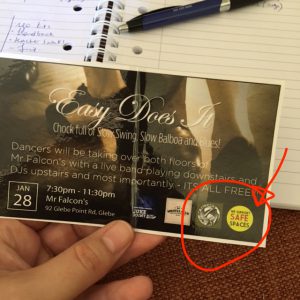A clever point was raised in the teaching swing dance fb group I’m part of.
This group has an excellent vibe: mutual respect, constructive talk, be nice.
Here is a question asked by one member of this group (I’ll keep her anonymous in case she needs to be, but will happily add her name later if necessary).
…there has long been a culture of “dominance” and coercive sexuality based on dance prowess or fame … in the swing scene. And it is absolutely tied to the rockstar status within subcultures.
What do we do to shut down the rock star culture, while still honoring those who are stellar teachers? What can International teachers do to take the focus off them as celebrities while the community at large promotes their contribution to dance and their value as teachers? (and I suppose we need to ask this of the competitor population, too, but I think the crossover population is the actually the one in question)
In conclusion, what can we each bring to our pool to help build a better community that supports our often juxtaposing desires?
This is what I wrote in response. The first paragraph is the most important, I think.
I don’t think the dance world is any worse than the rest of the world for assault and harassment. I actually think we do quite well on reporting and responding – hence the number of reports coming up in the last two years since we saw the public response to Steven Mitchell.
We are quite active and getting well organised in Australia, with almost all events and schools having codes of conduct, and a few events having really, really good response, reporting, and prevention strategies. Vivi Kalman and her MLX safety champs crew are well and truly leading the way on this.
Despite the awesomeness of some organisers, we do have some recalcitrant bastards who are either supporting accused men, or refusing to act beyond setting up dodgy cut and past codes of conduct.
But, well, baby steps.
We’ve also found in Australia that most reports of assault or harassment haven’t been reporting high profile or powerful male teachers. Offenders all sorts of men, most of whom are operating ‘under the radar’ for event organisers, but are well known among the more ‘intermediate’ or general dance population.
Personally, and as an organising person, I am much more worried about organisers and other teachers who cover for offenders. There is clearly a culture of hide-and-ignore protecting high profile male teachers who sexually assault women. There were certainly organisers who protected Steven Mitchell, and we have seen that other teachers protected Max Pitruzella.
So while I’m all for undoing some of the hero-worship and unquestioning adulation for teachers, I’m actually much more concerned about the way organisers protect known offenders. I think that organisers gain a lot of status from ‘getting’ the A-list teachers, and I know that organisers also risk money and status when they put on an event.
I’ve also seen that the worst offenders are booked by organisers who run events with exploitative conditions: underpaying or not paying teachers, DJs, staff; not making workplaces safe; overworking staff and volunteers, etc etc etc.
So I think that one very important way to combat this issue is to think of sexual assault and harassment as issues of power and exploitation (not sex), and that they are just one point on a spectrum of exploitation. So to prevent assault and harassment, we need to address broader issues of power and exploitation.
eg if you don’t run your event legit (eg don’t get visas for teachers, don’t pay tax, don’t pay people properly, don’t invoice properly), you’re less likely to call the police if you an assault is reported at your event. I’ve seen organisers botch things very badly when assaults are reported. eg letting an offender ‘apologise’ to classes before putting them on a plane. That’s a whole series of unethical and illegal actions there.
And one of the biggest issues in all of this, is that inexperienced people run events, and don’t know about half the issues that need addressing – from music use licences to OH&S, and beyond to writing agreements/contracts and how to manage people.
The dodgiest teachers (and why are there so many in the blues scene?) target these inexperienced people, saying they’ll pay their own flights over, if the local person puts on an event. The local person feels super flattered, puts on the event, and then all manner of bad shit goes down.


